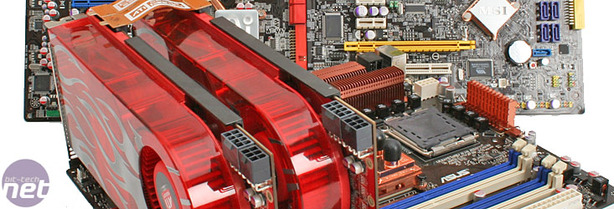Conclusions
I'm genuinely surprised, that the extra bandwidth actually does make a difference in some areas, but it didn't surprise us that there were cases where it didn't make any difference. Obviously we have the latency difference between motherboards and marginal extra performance the X38 brings, to take into account too, but the general consensus is you will likely see some improvement the more bandwidth you throw at CrossFire.However the actual degree of performance increase depends on how much your graphics cards of choice use the bus when operating in a multi-GPU configuration. If your cards are working harder doing more internal calculations, like for anti-aliasing or anisotropic filtering for example, there will be less data being sent between them as fewer frames are being rendered.
This is all a bit irrelevant though, as performance differences were quite often so small that general system optimisation or gentle overclocking of either the CPU, front side bus or graphics cards will negate any performance difference. That's not including just simply overclocking the PCI-Express bus to give you more speed if you're width is restricted to x8 or x4.
We would recommend avoiding virtually every P35 board that sports CrossFire as a feature, but that's not to say you should avoid P35 boards as a whole though - it's just CrossFire on in this situation is financially stupid. Why pay for a cheaper P35 board and then fork out for two expensive graphics cards when you can't get the most out of them?
We've always maintained that any multi-GPU system should only be considered if you've already run out of headroom after buying the fastest card anyway, so you're already financially committed. Don't go for a cheap rig with two mainstream cards and a mainstream board - it's still not worth it. A faster single card will not only offer better game compatibility, but more motherboard choice, generally lower power consumption and might also work out cheaper too.

While the Asus Blitz Extreme's dual x8 lanes should certainly suffice in terms of performance, the X38 not only provides that edge but also has PCI-Express 2.0 capabilities, thus delivering more bandwidth again (providing your graphics cards are PCIe 2.0 enabled - none are at the moment). And even though we don't expect twice the bandwidth to have a significant effect, because traditionally it never really has (AGP 2x, 4x, 8x and PCI-Express x16), it also has other benefits like having twice as much socket power.
With that said, this is something that we will be visiting in due course, however we're yet to get our hands on any PCI-Express 2.0 graphics cards. Hopefully that will change very soon though...

Final Thoughts
So I'm sure that one question on your mind is what should I buy? Well, next generation cards from AMD and Nvidia aren't far away at all if the rumours are to be believed. However, they're likely to command a premium for being new, unless they are particularly competitive with one another.If you've set your mind firmly on buying two cards then at least balance this off with an appropriate solution - there are cheaper vanilla X38 boards out there if you can't afford an Asus Blitz, and if you're already prepared to throw £200/300+ on a pair of graphics cards, investing in a decent board to pair them with should be a necessary thing to keep in mind. But remember, simply overclocking or tweaking the system for more performance will negate some of the advantages of more PCI-Express lanes and should provide a better overall performance for your everyday computing, rather than just gaming.

MSI MPG Velox 100R Chassis Review
October 14 2021 | 15:04









Want to comment? Please log in.